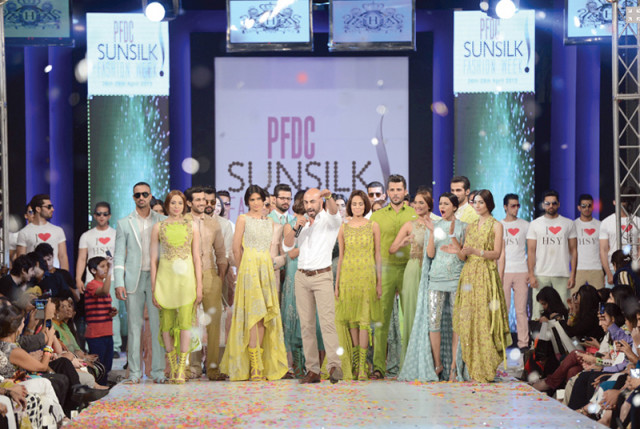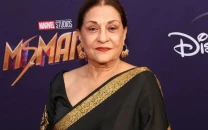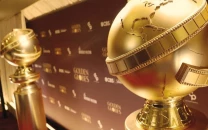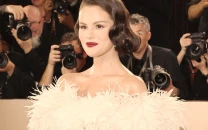Evolution of Pakistan Fashion Design Council
We look at how the council has revolutionised Pakistani fashion over the years.

PHOTO:FILE
As PFDC Sunsilk Fashion Week (PSFW), scheduled to take place in Lahore from April 10-13, 2014 draws nearer, the city is starting to buzz, as the business of fashion is about to begin.
When it comes to business of fashion, one cannot overlook the role the Pakistan Fashion Design Council (PFDC) has played in making fashion an industry in Pakistan. Starting out as a fashion platform, the PFDC today has become a brand name, churning out shows and creating brand awareness. It has brought fashion to the common man. Slowly and steadily, one can see fashion trickling down to high-street brands and inevitably becoming more accessible.
PFDC started out from the 13,000 sq ft Babul Shams marquee at Royal Palm and has now progressed to a total area of 43,056 sq ft at the Lahore Expo Centre. This alone can stand testament to its growth over the years. In recent history, we have seen fashion weeks come and go; Karachi Fashion Week and Islamabad Fashion Week are prime examples of platforms that failed to make a mark. Fashion Pakistan Week, even though it started out before PFDC, is still trying to find its bearings. In light of this, it is important to understand how PFDC has grown and why it has been successful. Being a non-profit organisation, it has allowed the council to keep its bearings on the right path. What the council has done right is the segmentation of the platform. While it began as a single-tier avenue for designers to showcase their collections; it has now become a four-tier platform with separate shows for Textile/Voile, High Street, Luxury/Pret and also has an entirely separate platform, the PFDC L’Oréal Bridal Week for bridal couture.
At Fashion Pakistan Week this year, we saw high-street brands being showcased alongside major luxury pret designers on the same platform. But that doesn’t work, because let’s say for example, you will never see H&M showcasing right after Armani on the same runway, hence, you cannot put Shamael Ansari next to Jafferjees. “It is important to segment the shows, because each segment caters to a wholly different market,” says PFDC CEO Saad Ali, “Not mixing and matching different strata of retailers in the same shows provides structure, and due attention can be paid to each segment separately.”
Despite protests from within the industry, this is one valuable lesson PFDC has learnt. Furthermore, it has instilled the concept of collections not only within the designers, but also among the consumers. You will now hear people referring to outfits in a very particular manner, for example, ‘This piece is from Sania Maskatiya’s Uraan Collection’.
“Initially there was a lack of interest and lack of confidence in having shows in Lahore,” says Hassan Sheheryar Yasin, founding member of PFDC. “It took some time to create discipline, but the by-product has been that designers now have the confidence to invest in ready-to-wear. Murky waters have become clearer and the council has found its niche.”
Moving on to designers and consistency of collections, it has become very apparent that retail is now the main focus of the council. “Our focus is on working in fashion to strengthen Pakistani fashion’s national production, retail and visibility,” continues Saad Ali, “We are interested in building institutions and not fleeting shows.”
Now, if a designer does not have the capacity to reproduce a collection for retail, they will not be allowed to show on the platform. Many of today’s high-profile designers such as Sania Maskatiya, Nida Azwer, Mohsin Ali, Ali Xeeshan etc, were launched under the PFDC umbrella and have gone out to expand their brand ethos and retail capacities. In the last two years, there has been an influx of standalone conceptualized designer retail outlets; giving the clients more options to pick up what they prefer.
“Sehyr Saigol is the main force behind it all and it’s great to be aligned with PFDC because things get done,” says Ali Xeeshan. “Not only is every collection pre-approved and individually worked on, but also, if tomorrow I don’t have money to make a collection, PFDC will find me a sponsor and that to me, is very supportive.”
Designers like Shehla Chatoor have had their set clientele in Punjab and showing at the platform has opened up more avenues for them. “It is extremely hassle-free and I can channel all my energies into designing,” says Chatoor. “I don’t have to worry about a thing, because everything is taken care off.”
It has been the consistent institution of discipline that has been a major factor that brands like L’Oréal and Sunsilk have stayed on as title sponsors, along with supporting partner brands such as Bank Alfalah, Lux, Ponds, Magnum, Lipton, and Diet Pepsi.
However, time management is still one of the foremost issues the event faces. Even though it has become better over the years, the shows are still delayed by an hour at least. “We have been working on reducing the delays, but there are issues with guests not showing up on time and subsequently the designers not wanting to start the shows,” says Saad Ali. “Now with three separate segments, we will have to start on time to set a precedent.”
Published in The Express Tribune, March 31st,2014.
Like Life & Style on Facebook, follow @ETLifeandStyle on Twitter for the latest in fashion, gossip and entertainment.



















COMMENTS
Comments are moderated and generally will be posted if they are on-topic and not abusive.
For more information, please see our Comments FAQ